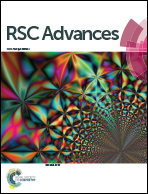Synthesis of 4-phenyl-5,6-dihydrobenzo[h]quinazolines and their evaluation as growth inhibitors of carcinoma cells†
Abstract
The synthesis of various benzo[h]quinazoline analogs (4a–f, 6a–d, 8a and 8b) was accomplished through the reaction of chalcone with guanidine. The synthesized compounds (4a–f, 6a–d, 8a and 8b) were screened for their anticancer potential against different cancer cells viz MCF-7, DLD1, A549, DU145 & FaDu cell lines. Compounds 4a, 6a–d & 8b showed significant anticancer activity in these cancer cell lines with a range of IC50 values of 1.5–12.99 μM. A functional study of promising molecule 6d at 7 μM (at the IC50 value) over 24 and 48 h showed that it possesses anticancer activity through triggering apoptosis. In a tubulin polymerization assay, 6d effectively inhibited tubulin polymerization with an IC50 of 2.27 μM. In silico docking studies of 6d revealed that 6d has good affinity with an estrogen receptor as well as a tubulin protein on its β-sheet of the colchicines binding site.
![Graphical abstract: Synthesis of 4-phenyl-5,6-dihydrobenzo[h]quinazolines and their evaluation as growth inhibitors of carcinoma cells](/en/Image/Get?imageInfo.ImageType=GA&imageInfo.ImageIdentifier.ManuscriptID=C5RA24429C&imageInfo.ImageIdentifier.Year=2016)


 Please wait while we load your content...
Please wait while we load your content...